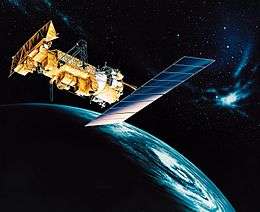NOAA-16
NOAA-16, designated NOAA-L before launch, is one of the NASA-provided TIROS series of weather forecasting satellites operated by NOAA.
 NOAA-16 before launch | |
| Mission type | Weather satellite |
|---|---|
| Operator | NOAA |
| COSPAR ID | 2000-055A |
| SATCAT no. | 26536 |
| Mission duration | 2 years planned[1] 14 years achieved |
| Spacecraft properties | |
| Spacecraft type | TIROS-N |
| Manufacturer | Lockheed Martin |
| Launch mass | 1,457 kilograms (3,212 lb)[2] |
| Power | 830 watts[3] |
| Start of mission | |
| Launch date | September 21, 2000, 10:22 UTC[4] |
| Rocket | Titan II(23)G Star-37XFP-ISS |
| Launch site | Vandenberg SLC-4W |
| End of mission | |
| Disposal | Decommissioned |
| Deactivated | June 9, 2014 |
| Orbital parameters | |
| Reference system | Geocentric |
| Regime | Sun-synchronous |
| Semi-major axis | 7,226.86 kilometers (4,490.56 mi)[5] |
| Eccentricity | 0.0009525[5] |
| Perigee altitude | 848 kilometers (527 mi)[5] |
| Apogee altitude | 862 kilometers (536 mi)[5] |
| Inclination | 98.96 degrees[5] |
| Period | 101.91 minutes[5] |
| Epoch | January 24, 2015, 11:59:04 UTC[5] |
Advanced TIROS-N | |
History
It was launched on September 21, 2000, in a sun-synchronous orbit, 849 km above the Earth, orbiting every 102 minutes. It hosts the AMSU, AVHRR and High Resolution Infrared Radiation Sounder (HIRS) instruments' APT transmitter. NOAA-16 has the same suite of instruments as carried by NOAA-15 plus an SBUV/2 instrument as well.[6]
NOAA-16's APT has been inoperable due to sensor degradation since November 15, 2000, and High Resolution Picture Transmission has been via STX-1 (1698 MHz) since November 9, 2010.[7]
NOAA-16 was decommissioned on June 9, 2014 after a critical anomaly.[7] On November 25, 2015, at 08:16, the JSpOC identified a possible breakup of NOAA 16 (#26536). All associated objects have been added to conjunction assessment screenings, and satellite operators will be notified of close approaches between the debris and active satellites. The JSpOC catalogs the debris objects when sufficient data is available.[8] As of March 26, 2016, 275 pieces of debris were being tracked.[9]
External Links
References
- Krebs, Gunter. "NOAA 15, 16, 17 (NOAA K, L, M)". Gunter's Space Page. Retrieved December 8, 2013.
- "NOAA 16". National Space Science Data Center. Retrieved December 9, 2013.
- "UCS Satellite Database". Union of Concerned Scientists. Retrieved December 9, 2013.
- McDowell, Jonathan. "Launch Log". Jonathan's Space Page. Retrieved December 9, 2013.
- "NOAA 16 Satellite details 2000-055A NORAD 26536". N2YO. January 24, 2015. Retrieved January 25, 2015.
- "NOAA-N Prime" (PDF). NP-2008-10-056-GSFC. NASA Goddard Space Flight Center. December 16, 2008. Archived from the original (PDF) on February 16, 2013. Retrieved October 8, 2010.
- NOAA 16 Spacecraft Status Summary Archived August 7, 2010, at the Wayback Machine
- "NOAA Weather Satellite suffers in-orbit Breakup". November 25, 2015. Retrieved November 25, 2015.
- T.S. Kelso, CelesTrak [@TSKelso] (March 26, 2016). "That brings the total so far for the NOAA 16 debris event to 275 pieces, with none having decayed from orbit" (Tweet). Retrieved March 28, 2016 – via Twitter.
